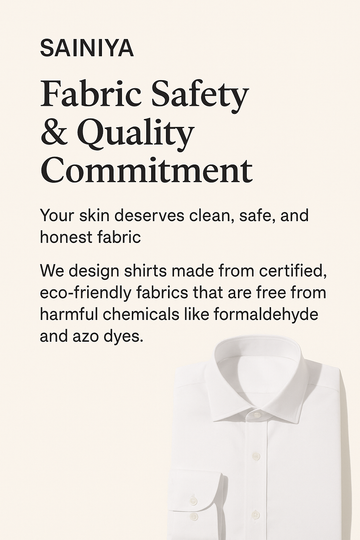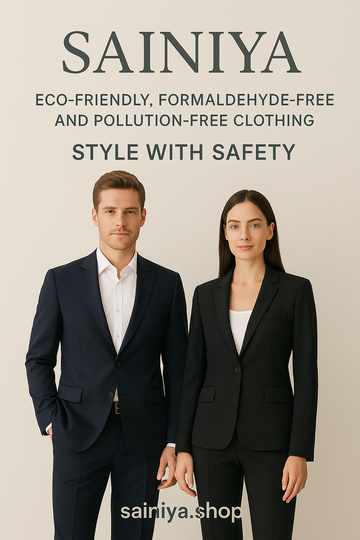SAINIYA Fabric Safety & Quality Commitment
Your Skin Deserves Clean, Safe, and Honest Fabric
At SAINIYA, we believe that true comfort starts from the fabric touching your skin. Every shirt we create goes through strict material selection, eco-friendly processing, and safety testing — so you can wear confidence every day.
Q&A: Understanding Shirt Fabrics and Hidden Risks
Q: What are the most common shirt fabrics?
A: Shirts are usually made from cotton, cotton blends, linen, silk, or polyester. Each has unique features — cotton is breathable and soft, blends are easy-care, linen feels cool, silk is elegant, and polyester is durable. However, to achieve “wrinkle-free” or “colorfast” effects, many fabrics undergo chemical finishing. Without strict control, some treatments can leave behind harmful substances.
Q: What harmful chemicals might remain in fabric?
A: Two of the most concerning are formaldehyde and azo dyes.
Formaldehyde is used in wrinkle-resistant finishes (e.g., DMDHEU resins). It can cause skin irritation or allergies with prolonged contact. (EPA)
Azo dyes may break down into aromatic amines, some of which are carcinogenic. (Textile Focus)
Other possible residues include heavy metals, VOCs, and plasticizers such as phthalates — all potentially irritating or harmful to skin health.
Q: How can these substances affect your health?
A: Exposure may lead to allergic dermatitis, rashes, itching, or respiratory irritation. Long-term exposure to certain chemicals can be linked to cancer or endocrine disruption. (American Cancer Society) That’s why safe, low-residue fabrics are essential for daily wear.
SAINIYA’s Safe Approach to Shirt Fabric Production
1. Certified Materials
We source only OEKO-TEX®, GOTS, or bluesign® certified fabrics — globally recognized for strict limits on harmful substances. Every supplier must pass safety audits and provide up-to-date laboratory reports before fabric approval.
2. Eco-Friendly Dyeing and Finishing
We strictly ban formaldehyde-based resins and unstable azo dyes, using safer alternatives and low-temperature, enzyme-assisted dyeing. All fabrics are thoroughly rinsed, neutralized, and tested for chemical residues.
3. Independent Safety Testing
Each batch of fabric and finished shirts undergoes formaldehyde, heavy metal, azo dye, and VOC residue testing. Certificates are available for viewing directly on sainiya.shop.
4. Full Transparency and Traceability
Every SAINIYA shirt can be traced back to its fabric batch and testing report through a unique ID or QR code. We share these results publicly to ensure full consumer trust.
5. Continuous Improvement
We regularly publish quality reports, partner with third-party testing agencies (SGS, Intertek, OEKO-TEX®), and update our internal safety standards to exceed global textile requirements.
Transparency, Comfort, and Responsibility
Our Promise:
No formaldehyde-releasing agents
No azo dyes that release aromatic amines
Certified safe fabrics only
Full batch traceability and testing transparency
Your Benefit:
Shirts that are not only stylish and breathable but also gentle on your skin and safe for daily wear.
Learn More
Visit sainiya.shop to explore our certified collections, read lab test summaries, and discover how SAINIYA is redefining what it means to wear safe, sustainable shirts.




